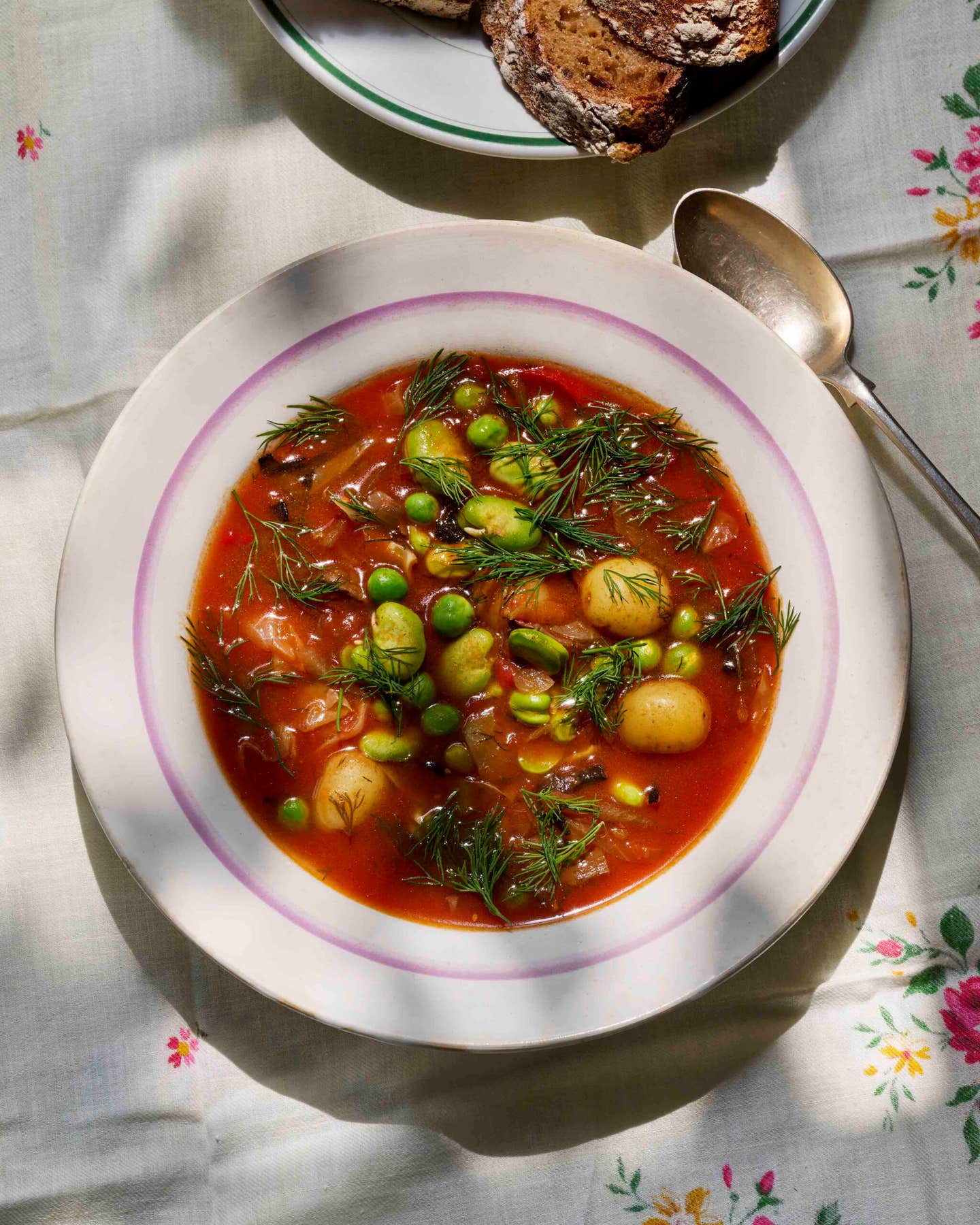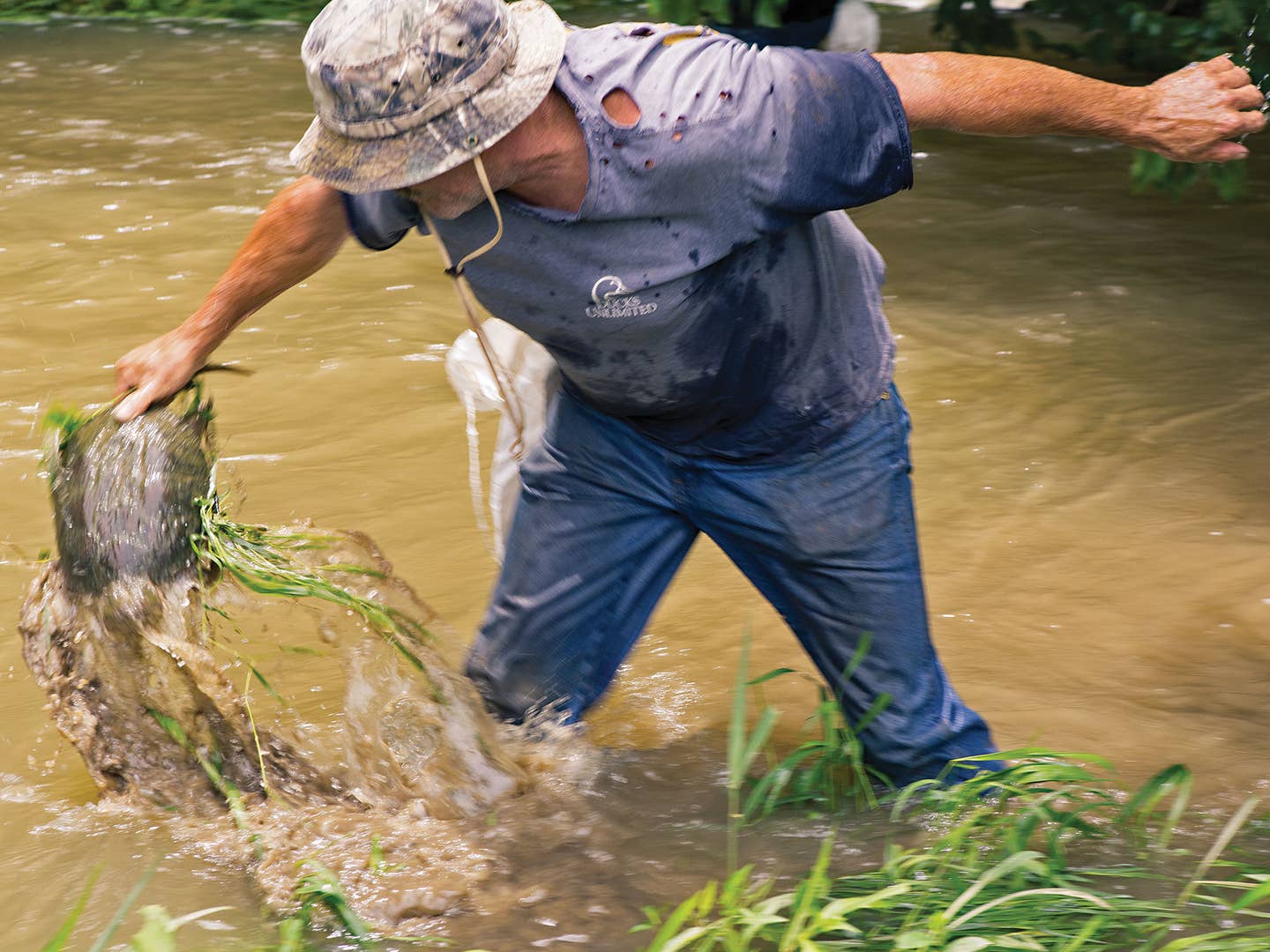
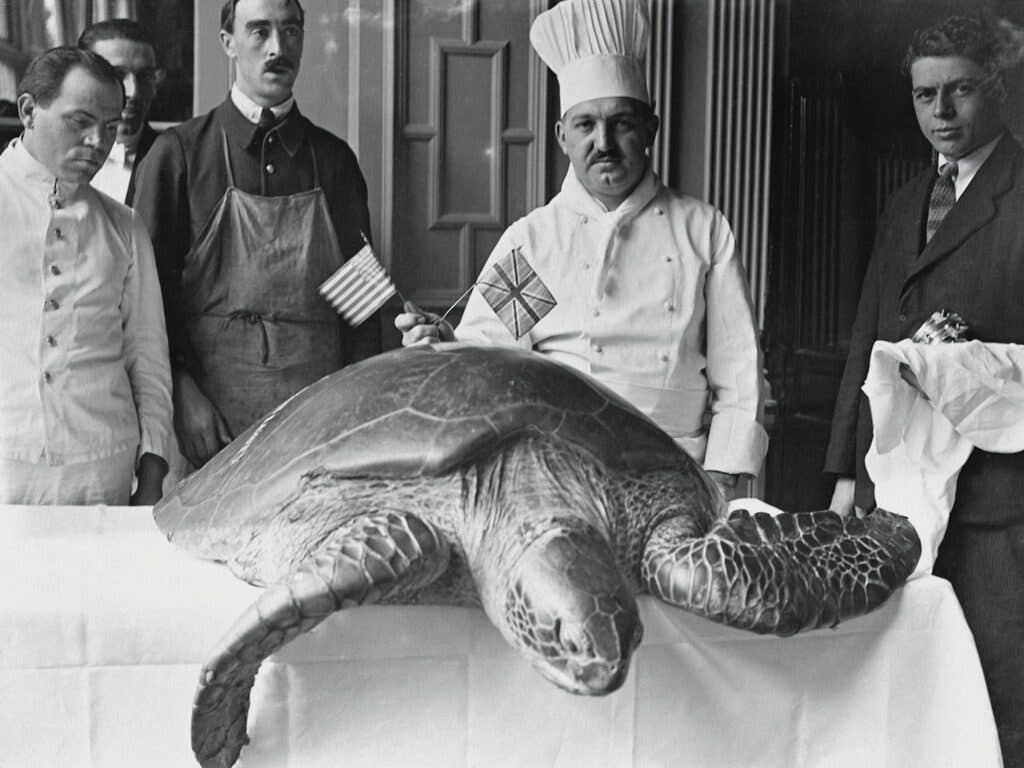
The best turtle hunting anywhere, I'd been told, was down this one road—“can't miss it”—in that far southwest outback of Virginia where the state resembles a wood planer peeling Kentucky off from Tennessee. One of the few champions of the almost extinct practice is Ricky Crouch, a logger whose South Carolina twang is music to my ears (I'm from there, too). But his directions, translated through crummy cell reception, ended up on paper as: “Past a gas station, out of business, a road goes off there, left, right, the one-lane bridge, and careful there's a rise where the road goes to gravel and it looks like you're going to drive off the earth.” And finally, before he hung up: “Don't worry, just get there and I'll find you.”
Somehow I did find that terrifying rise, then down Dean Hollow Road, past the Dean Cemetery, where I met Buster Dean, who's been hosting a turtle hunt at his farm for decades now. Crouch and assorted relatives and friends all gather here in this isolated little valley every July Fourth because they love the taste of snapping turtle and the intrigue of the hunt. They practice a style of turtle hunting that easily dates to before the Civil War and back to the very mists of the nation's founding.
I wanted to find out what had happened to turtle soup, which was among the most sought-after and popular dishes in all of American history. Accounts in the 18th and 19th centuries of massive parties known as “turtle frolics” suggest they were more popular than hog barbecues and oyster roasts, with descriptions of servants bearing three-foot-long upturned turtle shells filled with hot turtle stew for large crowds. No early cookbook lacked a recipe for turtle, terrapin, or snapper stew—made from sea turtle, snapping turtle, box turtle, or diamondback terrapin, all of which, in Southern slang, became “cooter” in the pot. But some 50 years ago, turtle soup disappeared and, to most palates, now seems almost improbable verging on unacceptable. What happened?
That was my question, and through a convoluted set of connections, I had been introduced to Ricky, who had told me right off that “ain't nothing like catching a big cooter and ain't nothing like eating one” and then invited me to join his July Fourth crew. So I packed my rubber boots.
“Look how nice Buster done scraped out the cow dung,” Ricky's father, Bud, said to me the night before the hunt, as folks started hauling in their gear to Buster's open-air cowshed, where they'd sleep. A five-foot-high pile of meadow muffins—days old, so no smell—marked the entrance. It was threatening to rain, so the assembled crew—a mixed-race group ranging from Ricky's five-year-old grandson Landon to 78-year-old Bud—all gathered inside to get supper going, blow up those new air mattresses a foot thick, and tell some stories.
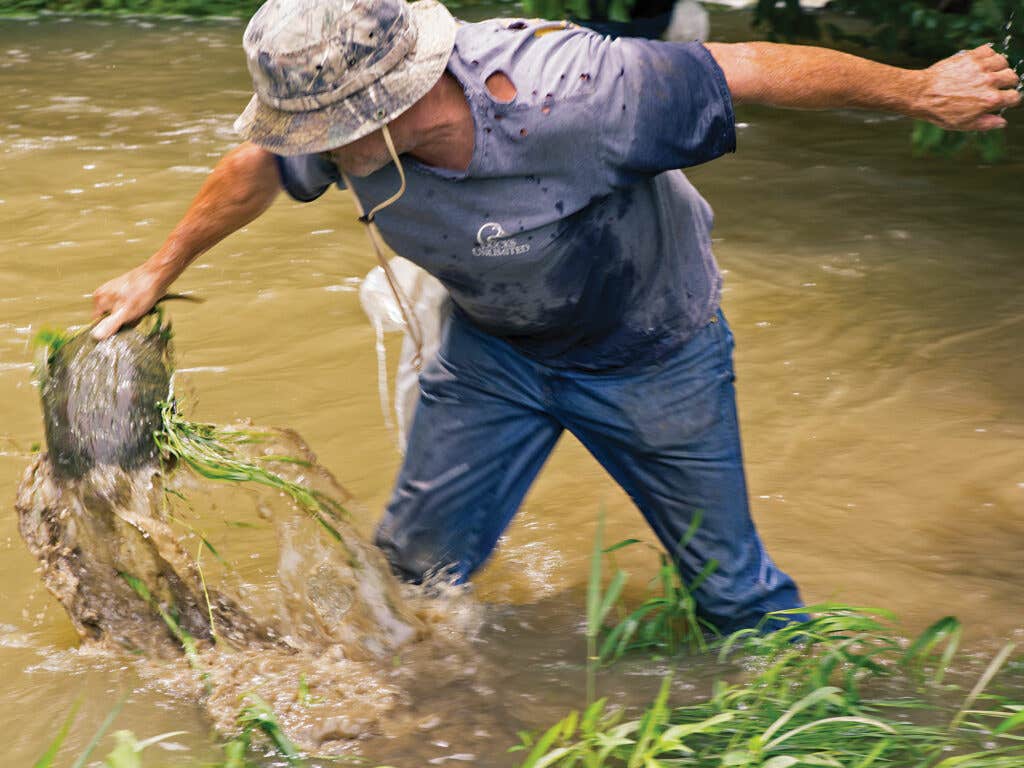
A retired cooter hunter, Frank Marshall, parked permanently in a portable easy chair, was there for the company and the moonshine. He asked me if I knew how to clean a turtle. I didn't. “Well,” he said, “you grab him by the tail, and you take some tissue and wipe his butt. Now, he's clean.” Laughter shook the shed wall, and all around, bullets of chaw blasted into the dust. According to legend, Ricky said, turtle is made up of a miscellany of meat, seven kinds—chicken, beef, lamb, goat, fish, pork, and shrimp. Bud piped up with the genesis story for my benefit: “They say that the Lord made the world in seven days, and he had a whole bunch of scraps left over. With those, he fashioned the cooter.”
For centuries, the flavor was legendary, and, really, nothing said American democracy like turtle. The poor man could often find a few slow-moving specimens hanging out at the backyard well, even as the privileged man sought out its refined flavor. Two days after voting for independence in Philadelphia, on July 4, 1776, John Adams celebrated with a bowl of turtle soup; when the war was over, George Washington met with his officers at Fraunces Tavern in lower Manhattan for a farewell frolic; and Lincoln celebrated his second inaugural with terrapin stew. Before Aaron Burr murdered Alexander Hamilton, both were members of the elite Hoboken Turtle Club.
Across the pond, the Brits also revered turtle soup. The Art of Cookery, Made Plain and Easy—By a Lady, England's great 18th century cookbook, boasts instructions on how "to dress a turtle the West India way" (a recipe that comes right after a "cure for the bite of a mad dog," which involves boiling "scraped tin" filings in good ale). Serving turtle in three different dishes at a frolic was not only common, it was, according to 1769's Experienced English House-Keeper, standard operating procedure.
Today, the memory of this dish has withdrawn into the fossil record of place names—Turtle Bay in midtown Manhattan centuries ago was a literal description of the area, same as Cooterville, Louisiana, and Turtlepoint, Pennsylvania. According to Paul Freedman, a food historian at Yale, the great fashion for turtle soup peters out in the mid-20th century.
“I have looked at menus from the Philadelphia Club, a fancy old men's club, and in the 1950s they not only still served terrapin, but packaged it in some form so you could take it home,” he told me, noting that because of “degradation of habitat, it became harder to get.” One can still find it served, say, in New Orleans' Commander's Palace and at the Oyster House in Philadelphia. But probably the easiest way to taste fresh-cooked turtle these days is to pull on some rubber boots and meet up with Ricky.
Early the morning of the hunt, after a platter of sausage, grits, and cornbread, we headed to the western end of the area known as Big Stone Gap, which has a notable lack of poisonous snakes, an abundance of turtles, and a holler full of welcoming farmers whose chickens get eaten by big snapping turtles and whose cows get tormented. When we arrived, about eight of us decided to work the creek. The rest, mostly kids, prowled the banks, shouting jokes and offering play-by-play cooter commentary.
We waded into a surging river up to our waists, pushing into a muscular flow strong enough to carry off a boy.
“You always walk upstream,” Ricky explained. “This way you don't muddy up the water, so you can see.” It was a slow trudge. Bud handed me a metal rod with a shepherd's crook at the end and showed me how to poke into the mud bank.
“Cooter like to hide out in muskrat dens,” he said. The dens are essentially air pockets carved into the river bank with easy access to the creek. We were after big turtles with shells the size of dinner plates or steering wheels, heads the size of a man's fist, and a mouth big enough, Ricky told me, to guillotine a finger in one swift motion. I poked into the mud with the rod, trying to sense an easy give that suggested a den.
“You run the rod up through the den,” Bud told me, “and you can tell the difference of the tink tink of a rock and not the thud thud of a turtle shell.”
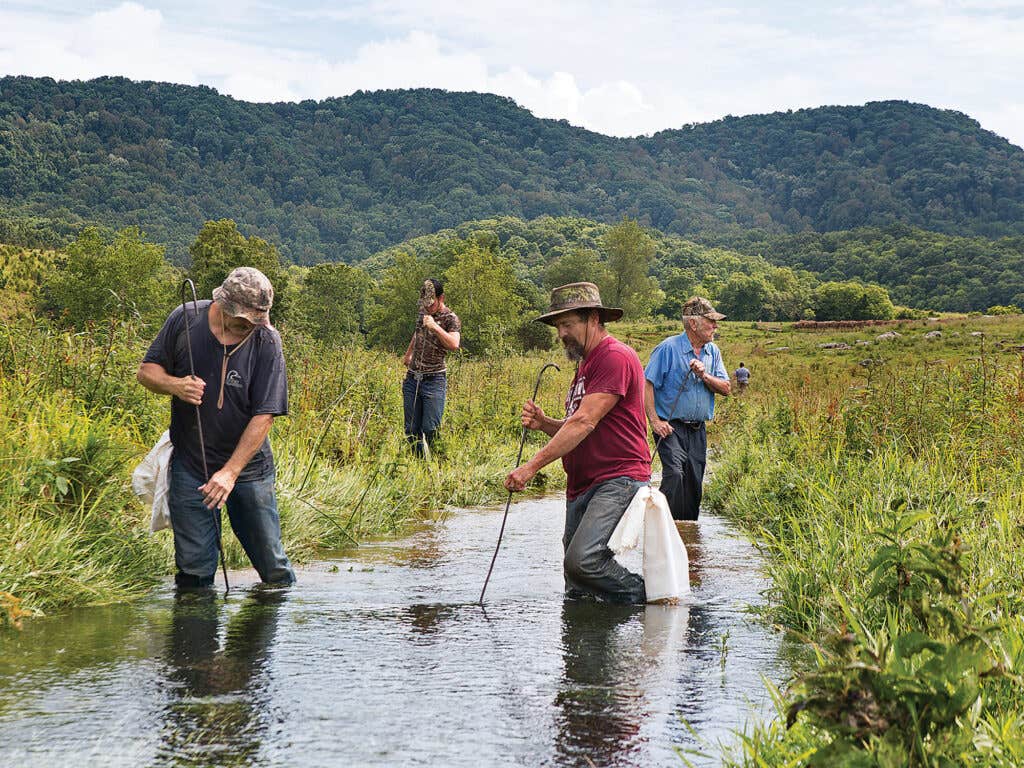
When you find one, Bud explained, put all five fingertips together to form your hand into a probing cone because “that way, the cooter can nick you but he can't really bite your finger.” A snapping turtle's shell is smooth on the edge but a bit serrated at the back end, and with that knowledge you can locate the tail, which you grab—that is, if you haven't encountered the head already.
At one point, Ricky found a den and invited me to “give it a look-see.” I glanced. “Put your hand in,” he said, laughing. I slowly put my hand through some roots and dirt and could feel the creepy sensation of open air inside. “Get on in there,” he said, sensing my greenhorn's hesitation, “you got to look around.”
I pushed my forearm into the dark wetness, my brain suddenly showcasing a cartoon cavalcade of nightmare visions. My body instinctively delivered one of those full-length bedtime jerks. I was comforted only by the fact that here in the water, no one could see that I was breaking out in the yellow sweat of a coward. “Let's find one with a cooter in it,” Ricky said helpfully.
We slow-motioned upstream with Ricky and Bud eagerly pushing their hands into the scariest-looking places imaginable—stump holes, thick briars, hanging tree roots. Fearless. I asked one of the boys for a gunnysack to carry so that I would at least appear to be doing something other than taking a very hard walk upstream because there was no way I was putting my arm in another den.
Ricky's son-in-law CJ was beside me and instructed, “You look for the snakiest place you can find, and then, everything your body says not to do, that's everything you gotta do.” He admitted that he'd been hunting for several years now but had never caught one. I took some solace in that.
Just then, Ronnie, a hunter, caught one swimming by. It bumped his leg and with lightning reflexes, he grabbed the tail, thick as a forearm, and held it up. It was big and his fierce head angled straight at me as I approached, a sharp beaky mouth opened in fury, hoping for a finger as he got lowered into a sack. That's the other thing. Snapping turtles are powerful in the water and Ricky told the story, from a few hunts ago, when Bud caught one the size of a manhole cover swimming away: “Bud was pulled by that one in a fast stream and his head slowly goes under and all we saw was bubbles.” In the end, Bud won that tug of war.
Ricky broke off talking as he'd spotted a nice thicket of loose roots, mud, and darkness, the kind of place that 100 million years of evolution had schooled the Golgi bodies in my every cell to walk widely around. Ricky trudged over, his arm now speckled with red dots of blood from poking past dozens of brambles and thorny bank growth. He plunged in, up to the elbow and then to the ball of his shoulder, the side of his face pressed into the muddy side of the creek bank, his feet taking the stabilizing stance of a linebacker. There were grunts and twists of his shoulder, and then he started to pull out his arm and suddenly, like some birth scene in Greek mythology, the river mud slurped open, and, before everyone's eyes, Ricky was gripping the tail of a dangling turtle, another big one, the size of a hubcap. Cheers went up, praise was generous, and one of the boys with a gunnysack ran over for the honor of toting the prize.
After two days of hunting, we all headed to Ricky's house in Chester, South Carolina, to clean his share, ten good-sized ones.
Cleaning a turtle is not easy. First, there is the killing, and there is nothing to say here except you need a really sharp knife and a swift hand. I lopped the head off, drained the blood, and commenced with the hard part: Cutting out the bottom of the shell, the plastron, separating it from the carapace. Inside are the organs and an ample amount of yellow fat, which is not at all desirable. One of Ricky's friends, Bubba, who was helping out this afternoon, told me he accidentally got a mouthful of that fat in some badly prepared cooter and couldn't eat it for a decade.
The tough outer reptilian skin can be removed after a quick scalding, and then what's left are two large pieces of good meat, the back quarters including the tail and the front legs along with the neck. In the shell those two parts are nearly separate, barely connected by a double strip of loin nestled into its own bony cage in the center well.
The thing about an average turtle is that once cleaned, it will yield about three or four pounds of meat, so it's easy to see why it was once the workingman's meal. At any house with a well, there might be one or two turtles hanging out in the nearby puddles. I ran across accounts of people finding turtles here and there and tossing them into the water barrel at the well until there were enough to invite friends over for a frolic.
So, another explanation for their disappearance from the common menu, along with Freedman's argument about degradation of habitat, might well be indoor plumbing. Easy access to turtle was eliminated when we piped water directly into the house, allowing the once-visible turtle to withdraw into the creeks and swamps, back to the muskrat dens where Ricky and Bud still look for them every year.
Ricky generously let me bag about eight pounds of neck and legs on ice, along with some of the loin still locked into the shells. And with that in the backseat, I drove off to Chapel Hill, North Carolina, to visit James Beard Award—winner Bill Smith, the legendary chef at Crook's Corner.
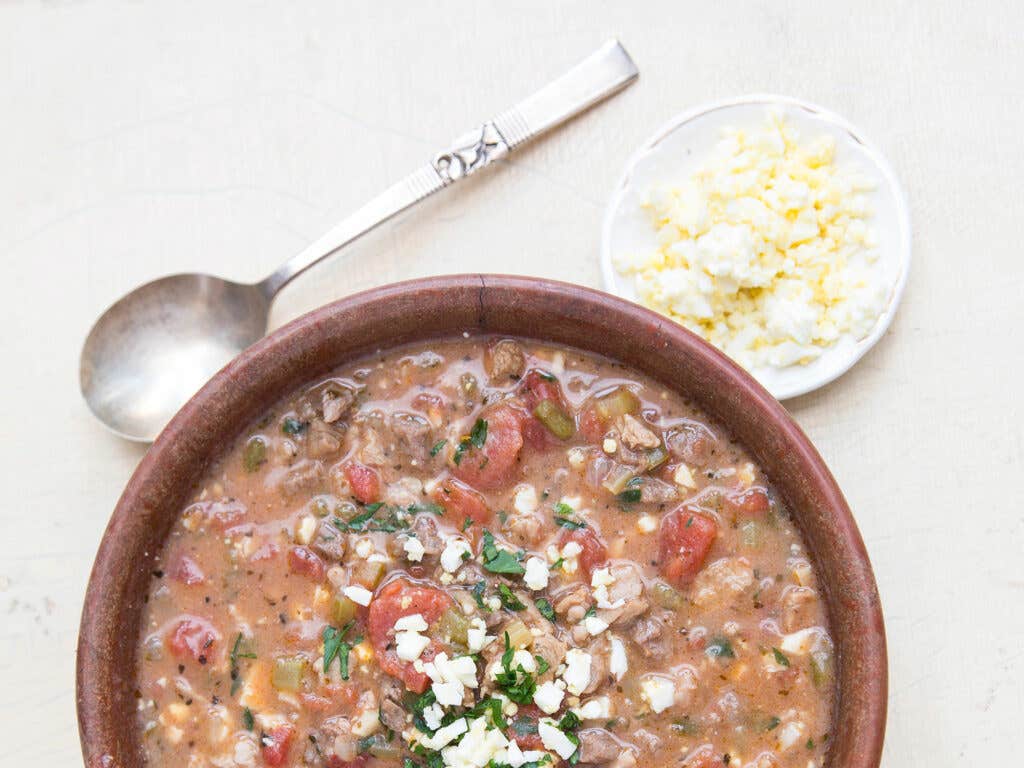
Once a year, Smith cooks cooter soup according to his own recipe, which is based on the kind of preparation that would have been familiar to presidents of yore.
“I love turtle soup, and every Mardi Gras season, I bring it onto the menu,” Smith said. “This is a Southern restaurant and I feel like I need to do this—and it's a great break from typical winter fare.”
While we boned the legs and the necks, we roasted the loin in the shell with some butter and herbs in a 400-degree oven for 30 minutes. Afterward, with some intense poultry-shear wrestling, I eventually popped that piece of meat from its bony cage. It was about the size of a small chicken cutlet, only slightly tough. The aroma was bright, clean, and meaty—somewhere between crab and beef—a smell that 100 million years of evolution were telling me, yes.
Smith's turtle soup is based on the classic New Orleans bowl, which means that once you've gotten the meat cooked and properly prepared with lots of tomatoes and the rest, you thicken up the sauce with a dark mixture called “peanut butter” roux, not because of the ingredients but because of its color. A half-hour of simmering later, we scooped ourselves some dark red bowls.
If you mark waterborne foods along a continuum, with the sweet, rich taste of, say, fresh crab or salmon or lobster on one side, and on the other the strong marine flavor of mackerel, bluefish, or trout, turtle falls squarely in the savory phylum. Tasting our bowls, Bill and I circled around our terms until we landed on, “tastes like sturgeon.”
Crook's Corner was cranking up for business the morning we started cooking. So sous chefs, managers, waiters, and bottle-washers were coming and going—stocks started, cornbread cooked, tables scrubbed down. One eagerly wanted a taste but another wanted nothing to do with it. A friend of Smith's who stopped by, a big meat eater, told us she'd pass.
“I just don't think I can do it,” she said.
Indeed, turtle's disappearance may be partly due to the fact that its persona, over the years, has shifted away from easily accessible food toward something anthropomorphic, more like a loveable cartoon character—see: Yertle, Franklin, Cecil, and Touché, not to mention Donatello and that whole gang.
But there may be yet another explanation: There was a big shift in tastes somewhere after World War I, Freedman told me. It's hard not to note the sheer variety of what was available before then, not just of turtle, but of all manner of meats.
Menus from that time routinely offered everything from roasted snipe and plover to rabbit hash, mutton cutlets, and oxtail. The decline of the family farm and the rise of mechanized factory farming, a process described as the "Eden Crash" in Christopher Leonard's Meat Racket, meant that by World War II, American taste for meat had bottlenecked into chicken, pork, and beef, all three of which could be grown, fed, quartered, and slaughtered according to the efficiency demands of Henry Ford's assembly-line theories. And I can testify that gutting and cleaning turtle is a big hassle and a poor candidate for any kind of industrial streamlining.
That's one reason Ricky is out there every July: He's hunting not just turtle, but also that wide variety of flavors that now hides out far from the streamlined meat aisles of the Piggly Wiggly. Take the sausage Ricky was cooking for breakfast that first morning. The boys were down at the creek fishing out little brim and tossing them in a barrel to be cooked later, and Ricky was telling me that I had to give the sausage a try. He'd cleaned timber for a guy who raised his own pigs in his own way, and bartered for the meat. The guy made his own homemade sausage, Ricky told me, and it tastes better than anything you've ever had.
Keep Reading
Continue to Next Story









